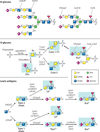Protein glycosylation in cancer
- PMID: 25621663
- PMCID: PMC4396820
- DOI: 10.1146/annurev-pathol-012414-040438
Protein glycosylation in cancer
Abstract
Neoplastic transformation results in a wide variety of cellular alterations that impact the growth, survival, and general behavior of affected tissue. Although genetic alterations underpin the development of neoplastic disease, epigenetic changes can exert an equally significant effect on neoplastic transformation. Among neoplasia-associated epigenetic alterations, changes in cellular glycosylation have recently received attention as a key component of neoplastic progression. Alterations in glycosylation appear to not only directly impact cell growth and survival but also facilitate tumor-induced immunomodulation and eventual metastasis. Many of these changes may support neoplastic progression, and unique alterations in tumor-associated glycosylation may also serve as a distinct feature of cancer cells and therefore provide novel diagnostic and even therapeutic targets.
Keywords: biomarkers; cancer; glycans; glycoprotein; glycosylation; immunohistochemistry; oligosaccharides; transformation.
Figures





Similar articles
-
Glycosylation and metastases.Electrophoresis. 2019 Jan;40(1):140-150. doi: 10.1002/elps.201800238. Epub 2018 Oct 25. Electrophoresis. 2019. PMID: 30246896 Review.
-
When Glycosylation Meets Blood Cells: A Glance of the Aberrant Glycosylation in Hematological Malignancies.Rev Physiol Biochem Pharmacol. 2021;180:85-117. doi: 10.1007/112_2021_60. Rev Physiol Biochem Pharmacol. 2021. PMID: 34031738 Review.
-
On the trail of the glycan codes stored in cancer-related cell adhesion proteins.Biochim Biophys Acta Gen Subj. 2017 Jan;1861(1 Pt A):3237-3257. doi: 10.1016/j.bbagen.2016.08.007. Epub 2016 Aug 23. Biochim Biophys Acta Gen Subj. 2017. PMID: 27565356 Review.
-
Epigenetic Regulation of the Biosynthesis & Enzymatic Modification of Heparan Sulfate Proteoglycans: Implications for Tumorigenesis and Cancer Biomarkers.Int J Mol Sci. 2017 Jun 26;18(7):1361. doi: 10.3390/ijms18071361. Int J Mol Sci. 2017. PMID: 28672878 Free PMC article. Review.
-
Protein glycosylation in cancers and its potential therapeutic applications in neuroblastoma.J Hematol Oncol. 2016 Sep 29;9(1):100. doi: 10.1186/s13045-016-0334-6. J Hematol Oncol. 2016. PMID: 27686492 Free PMC article. Review.
Cited by
-
ZikaVR: An Integrated Zika Virus Resource for Genomics, Proteomics, Phylogenetic and Therapeutic Analysis.Sci Rep. 2016 Sep 16;6:32713. doi: 10.1038/srep32713. Sci Rep. 2016. PMID: 27633273 Free PMC article.
-
Cosmc controls B cell homing.Nat Commun. 2020 Aug 10;11(1):3990. doi: 10.1038/s41467-020-17765-6. Nat Commun. 2020. PMID: 32778659 Free PMC article.
-
Post-translational modifications: The potential ways for killing cancer stem cells.Heliyon. 2024 Jul 4;10(14):e34015. doi: 10.1016/j.heliyon.2024.e34015. eCollection 2024 Jul 30. Heliyon. 2024. PMID: 39092260 Free PMC article. Review.
-
N-Glycoproteins Have a Major Role in MGL Binding to Colorectal Cancer Cell Lines: Associations with Overall Proteome Diversity.Int J Mol Sci. 2020 Aug 1;21(15):5522. doi: 10.3390/ijms21155522. Int J Mol Sci. 2020. PMID: 32752259 Free PMC article.
-
Cosmc overexpression enhances malignancies in human colon cancer.J Cell Mol Med. 2020 Jan;24(1):362-370. doi: 10.1111/jcmm.14740. Epub 2019 Oct 21. J Cell Mol Med. 2020. PMID: 31633299 Free PMC article.
References
-
- Lengauer C, Kinzler KW, Vogelstein B. Genetic instabilities in human cancers. Nature. 1998;396:643–649. - PubMed
-
- Fuster MM, Esko JD. The sweet and sour of cancer: glycans as novel therapeutic targets. Nat. Rev. Cancer. 2005;5:526–542. - PubMed
-
- Jones PA, Laird PW. Cancer epigenetics comes of age. Nat. Genet. 1999;21:163–167. - PubMed
Publication types
MeSH terms
Substances
Grants and funding
LinkOut - more resources
Full Text Sources
Other Literature Sources

